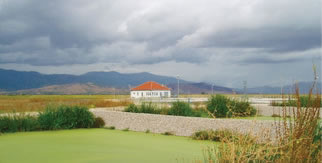
Environmental Science and Engineering
Application of Simulation-Optimization Methods for Management of Nitrate Loading to Groundwater From Decentralized Wastewater Treatment Systems Near La Pine, Oregon
Publication Date: July 2006
Cooperating Institution: Deschutes County Environmental Health
Principal Investigator: Roger Everett
Project Budget: $92,777
Project Identifier: WU-HT-03-37
DESCRIPTION
Physically-based numerical models are valuable tools for managing water resources because of their ability to simulate the complex behavior of ground-water systems. Simulation models alone, however, cannot necessarily identify optimal solutions to ground-water management problems. Mathematical optimization techniques have been used with simulation models to identify optimal solutions to management problems, although little effort has been made to apply these techniques to ground-water quality issues associated with the use of decentralized wastewater treatment systems. The simulation-optimization approach is appealing because it can account for both the complex behavior of a ground-water flow system and identify the best management strategy to achieve prescribed constraints.
This project will evaluate various optimization techniques with respect to their applicability to development of risk-based management programs in communities utilizing decentralized wastewater treatment. Many communities are faced with land-use and wastewater treatment planning decisions related to the protection of ground-water quality, the consequences of which can be costly, and should thus be supported by the best possible information. Simulation models can be expensive to develop, largely because they require more data than some other techniques, such as mass balance calculations. However, where simulation models are justified due to the complexity of the ground-water system and need for predictive capability, the use of optimization can actually reduce the cost of using the simulation model to identify best management strategies. It should be noted that the simulation models are available for many communities, and even if they were initially developed for other purposes, can often be cost-effectively adapted to address water-quality issues.
This research is important because it will demonstrate how the simulation-optimization approach can be applied to a new class of resource management problem—identifying the optimal distribution and rate of non-point source loading that achieves ground-water quality protection goals and land-use objectives. The objective of this project is to develop a practical, cost-effective method of using distributed nitrogen transport models with optimization techniques to support risk-based decision making and management of water quality. The project will produce a technical report that describes the method and provides guidance on application to other areas.

